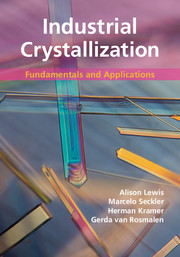Book contents
- Frontmatter
- Contents
- Nomenclature
- Industrial crystallization in practice: from process to product
- 1 Thermodynamics, crystallization methods and supersaturation
- 2 Characterization of a crystalline product
- 3 Basic process design for crystallization
- 4 Nucleation
- 5 Crystal growth
- 6 Agglomeration
- 7 The population balance equation
- 8 Batch crystallization
- 9 Measuring techniques
- 10 Industrial crystallizers
- 11 Precipitation and anti-solvent crystallization
- 12 Melt crystallization
- 13 Additives and impurities
- 14 Polymorphism
- Index
- References
11 - Precipitation and anti-solvent crystallization
Published online by Cambridge University Press: 05 July 2015
- Frontmatter
- Contents
- Nomenclature
- Industrial crystallization in practice: from process to product
- 1 Thermodynamics, crystallization methods and supersaturation
- 2 Characterization of a crystalline product
- 3 Basic process design for crystallization
- 4 Nucleation
- 5 Crystal growth
- 6 Agglomeration
- 7 The population balance equation
- 8 Batch crystallization
- 9 Measuring techniques
- 10 Industrial crystallizers
- 11 Precipitation and anti-solvent crystallization
- 12 Melt crystallization
- 13 Additives and impurities
- 14 Polymorphism
- Index
- References
Summary
Why this chapter is important
Precipitation processes are important in a number of different fields, including extractive metallurgy, where the high recovery (i.e. recovered mass/initial mass in solution) is exploited to recover valuable metals; water treatment, where the same high recovery is exploited to cause high levels of removal of contaminants; pharmaceuticals, where a high recovery of product is important; and nano-precipitation, where the small particle size and a monodisperse crystal size distribution are important.
What is precipitation?
The distinction between crystallization and precipitation is often based on the speed of the process, with precipitation usually being defined as a fast process that results in rapid solid formation of extremely small crystals (Jarvenin,8). However, a more scientific definition of precipitation is the fact that the product is formed by a chemical reaction. Thus, precipitation is often referred to as “reactive crystallization.”
In precipitation processes, two soluble reactants are mixed to form a sparingly soluble product. What makes it unique is that often, especially in high-recovery precipitation, the reagent streams are highly concentrated and thus very high supersaturations, especially local supersaturations, are created (Figure 11.1). Because of the high supersaturation, the conversion of the solutes into solid particles is (in contrast to crystallization) usually a very fast process.
What makes it unique?
Precipitation is used for sparingly soluble substances (solubility in the range 0.001−1 kg m−3) for a number of reasons, but mostly because of:
a. the requirement for a high recovery of the product;
b. the requirement for a high degree of removal of a species;
c. other techniques not being suitable. For example, cooling crystallization is not suitable if the compound has a flat or retrograde solubility curve, whilst evaporative crystallization is too expensive due to the volume of the water to be evaporated.
- Type
- Chapter
- Information
- Industrial CrystallizationFundamentals and Applications, pp. 234 - 260Publisher: Cambridge University PressPrint publication year: 2015



